-
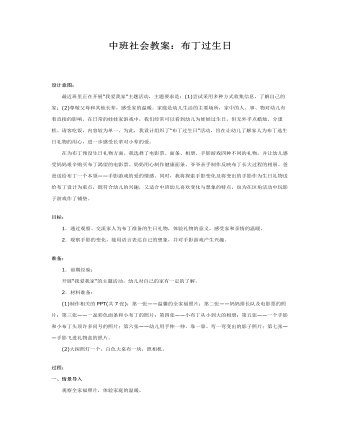
中班社会教案:布丁过生日
(2)尊敬父母和其他长辈,感受家的温暖。家庭是幼儿生活的主要场所,家中的人、事、物对幼儿有着直接的影响。在日常的娃娃家游戏中,我们经常可以看到幼儿为娃娃过生日,但无外乎点蜡烛、分蛋糕、请客吃饭,内容较为单一。为此,我设计组织了“布丁过生日”活动,旨在让幼儿了解家人为布丁选生日礼物的用心,进一步感受长辈对小辈的爱。 在为布丁预设生日礼物方面。我选择了电影票、面条、相册、手影游戏四种不同的礼物,并让幼儿感受妈妈艰辛购买布丁渴望的电影票、奶奶用心制作健康面条、爷爷亲手制作反映布丁长大过程的相册、爸爸送给布丁一个本领——手影游戏的爱的情感。同时,我将探索手影变化及将变出的手影作为生日礼物送给布丁设计为重点,既符合幼儿的兴趣,又适合中班幼儿喜欢变化与想象的特点,也为在区角活动中玩影子游戏作了铺垫。目标:1.通过观察、交流家人为布丁准备的生日礼物,体验礼物的意义,感受家和亲情的温暖。2.观察手影的变化,能用语言表达自己的想象,并对手影游戏产生兴趣。准备:1.前期经验: 开展“我爱我家”的主题活动,幼儿对自己的家有一定的了解。
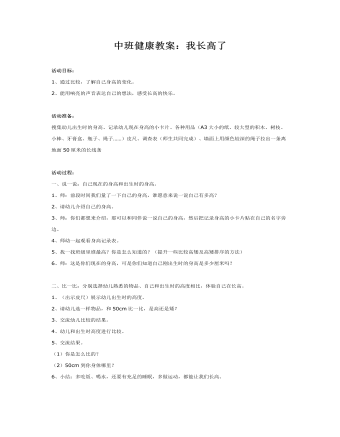
中班健康教案:我长高了
活动准备:搜集幼儿出生时的身高、记录幼儿现在身高的小卡片、各种用品(A3大小的纸、较大型的积木、树枝、小棒、牙膏盒、瓶子、绳子……)皮尺、调查表(师生共同完成)、墙面上用颜色较深的绳子拉出一条离地面50厘米的长线条 活动过程:一、说一说:自己现在的身高和出生时的身高。1、师:前段时间我们量了一下自己的身高,谁愿意来说一说自己有多高?2、请幼儿介绍自己的身高。3、师:你们都想来介绍,那可以和同伴说一说自己的身高,然后把记录身高的小卡片贴在自己的名字旁边。4、师幼一起观看身高记录表。5、找一找班级里谁最高?你是怎么知道的?(提升一些比较高矮及高矮排序的方法)6、师:这是你们现在的身高,可是你们知道自己刚出生时的身高是多少厘米吗?
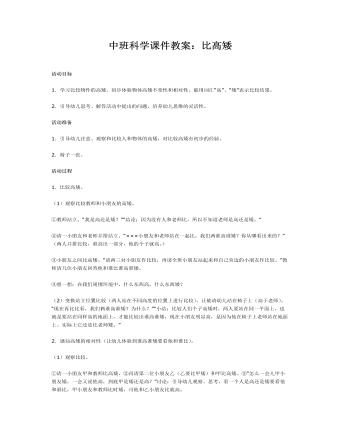
中班科学课件教案:比高矮
2.引导幼儿思考、解答活动中提出的问题,培养幼儿思维的灵活性。活动准备1.引导幼儿注意、观察和比较人和物体的高矮,对比较高矮有初步的经验。2.椅子一张。活动过程1.比较高矮。(1)观察比较教师和小朋友的高矮。①教师站立。“我是高还是矮?”“结论:因为没有人和老师比,所以不知道老师是高还是矮。”②请一小朋友和老师并排站立。“×××小朋友和老师站在一起比,我们两谁高谁矮?你从哪看出来的?”(两人并排比较,谁高出一部分,他的个子就高。)
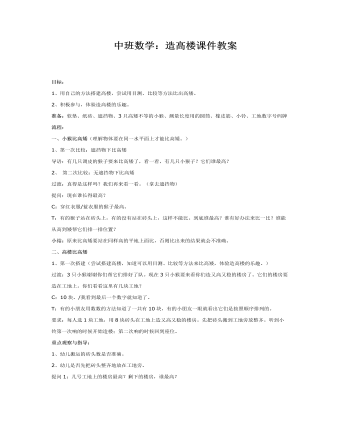
中班数学:造高楼课件教案
2、积极参与,体验造高楼的乐趣。准备:软垫、纸砖、遮挡物、3只高矮不等的小猴、测量长度用的圆筒、橡皮筋、小铃、工地数字号码牌流程:一、小猴比高矮(理解物体要在同一水平面上才能比高矮。) 1、第一次比较:遮挡物下比高矮 导语:有几只调皮的猴子要来比高矮了,看一看,有几只小猴子?它们谁最高? 2、第二次比较:无遮挡物下比高矮 过渡:真得是这样吗?我们再来看一看。(拿去遮挡物) 提问:现在谁长得最高? C:穿红衣服/蓝衣服的猴子最高。 T:有的猴子站在砖头上,有的没有站在砖头上,这样不能比。到底谁最高?谁有好办法来比一比?谁能从高到矮帮它们排一排位置? 小结:原来比高矮要站在同样高的平地上面比,否则比出来的结果就会不准确。
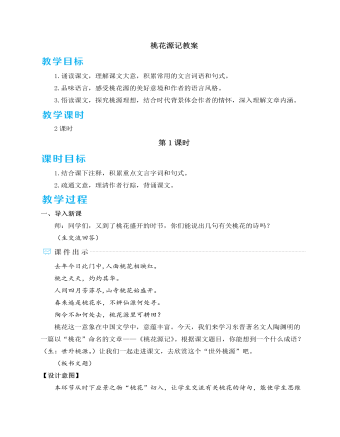
人教部编版语文八年级下册我一生中的重要抉择教案
五、总结存储1.教师总结这篇演讲词,作者用幽默诙谐的语言阐述了自己人生中的一个重要抉择——大力扶植年轻人。作者善于自我调侃,在自我解剖中进行了深入的分析,强调了扶植年轻人的重要性和必要性。演讲中列举了大量名人事例进行论证,使演讲具有很强的说服力。这篇演讲词展示了一位科学家精彩绝伦的语言魅力:不但有科学原理,而且有人生哲理;不但有学术的穿透力,而且有情感的震撼力;不但有理论的清晰度,而且有语言的幽默感——这一切构成了王选演讲的独特风采。我们在体会王选演讲魅力的同时,也领略到了他的人格魅力。2.布置作业(1)人的一生所做的重要抉择,如果与时代和国家紧密相连,意义会更加重大。我们在人生的关键阶段,如选择未来事业时,会做出怎样的抉择?请你写一段200字左右的演讲词,并在小组内演讲交流。(2)课外阅读王选的《我一生中的八个重要抉择》。

初中化学人教版九年级上册《实验活动3燃烧的条件》教案
【学习目标】1.知识与技能:加深对燃烧条件的认识,进一步了解灭火的原理。2.过程与方法:体验实验探究的过程,学习利用实验探究的方法研究化学。3.情感态度与价值观:利用化学知识解释实际生活中的具体问题,使学生充分体会到化学来源于生活,服务于社会。【学习重点】通过物质燃烧条件的探究,学习利用控制变量的思想设计探究实验,说明探究实验的一般过程和方法。【学习难点】利用控制变量的思想设计对照实验进行物质燃烧条件的探究。【课前准备】《精英新课堂》:预习学生用书的“早预习先起步”。《名师测控》:预习赠送的《提分宝典》。情景导入 生成问题1.复习:什么叫燃烧?燃烧条件有哪些?今天自己设计实验来进行探究。2.明确实验目标,导入新课。合作探究 生成能力学生阅读课本P150的相关内容并掌握以下内容。实验用品:镊子、烧杯、坩埚钳、三脚架、薄铜片、酒精、棉花、乒乓球、滤纸、蜡烛。你还需要的实验用品:酒精灯、水。1.实验:用棉花分别蘸酒精和水,放到酒精灯火焰上加热片刻。上述实验中我们能观察到什么现象?说明燃烧需要什么条件?如果在酒精灯上加热时间较长,会发生什么现象?答:蘸酒精的棉花燃烧,蘸水的棉花没有燃烧,说明燃烧需要有可燃物。如果加热时间较长,水蒸发后,蘸水的棉花也会燃烧。2.如图所示,进行实验:我们能观察到什么现象?说明燃烧需要什么条件?答:在酒精灯火焰上加热乒乓球碎片和滤纸碎片,都能燃烧,说明二者都是可燃物。放在铜片两侧给它们加热后可看到乒乓球碎片先燃烧,说明燃烧需要温度达到可燃物的着火点。3.你能利用蜡烛和烧杯(或选择其他用品)设计一个简单实验证明燃烧需要氧气(或空气)吗?答:点燃两支相同的蜡烛,然后在一支蜡烛上扣住一只杯子,看到被杯子扣住的蜡烛一会儿就熄灭,说明燃烧的条件之一是需要氧气。

《中国人民解放军军歌》教案
教学过程:一、组织教学学生跟随着《军队进行曲》步入音乐教室,并伴随着音乐原地踏步,师生问好。(情景教学)二、导入(为新课铺垫)1、根据课前所放的《军队进行曲》,提问同学的步伐整齐是因为什么原因?(踩着音乐的节拍行进)2、说说《军队进行曲》的节拍是怎样的?(二拍子,强拍在第一拍上)3、伴随着音乐走进教室时,你听到音乐后的感受是什么?(节奏感强、雄壮有力、激昂)4、把刚才分析的《军队进行曲》的特点合在一起,就是进行曲的特点,导出进行曲。5、众多进行曲中,你所熟悉的进行曲都有哪些?(《中国人民解放军军歌》、《婚礼进行曲》、《葬礼进行曲》等)三、新授1、放一段带有阅兵式画面的录像,引出《中国人民解放军军歌》。2、学生介绍作者郑律成。3、欣赏《中国人民解放军军歌》。4、赏析《中国人民解放军军歌》。①欣赏此曲后的感受。(振奋人心)②欣赏后给你留下最深刻的是哪段音乐(最容易哼唱的部分)?(开头:向前、向前、向前!我们的队伍向太阳……)③分析开头的旋律:同音重复(只有一个音ⅰ组成),不加任何节奏的演唱和加入附点和切分节奏的演唱,比较二者的区别,感受加上附点和切分节奏后给人的感觉是什么?(具有号召性节奏铿锵,振奋人心)
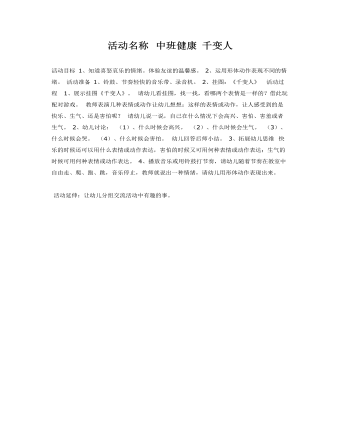
中班健康:千变人课件教案
2、运用形体动作表现不同的情绪。活动准备 1、铃鼓、节奏轻快的音乐带、录音机。 2、挂图:《千变人》 活动过程 1、展示挂图《千变人》。 请幼儿看挂图,找一找,看哪两个表情是一样的?借此玩配对游戏。 教师表演几种表情或动作让幼儿想想:这样的表情或动作,让人感受到的是快乐、生气、还是害怕呢? 请幼儿说一说,自己在什么情况下会高兴、害怕、害羞或者生气。
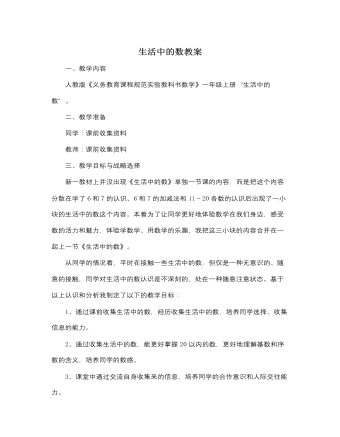
人教版新课标小学数学一年级上册生活中的数教案
六、教学反思 从这节课的实施情况看,课堂实施与原先的公开课教案是比较一致的,效果也是比较好的,主要体现于以下两点: 1、效果得益于“跳出”--跳出教材框框 刚开始备课和试教时,我打算充沛利用教材,根据教材上的内容出示幻灯片让同学说一说,但一节课下来显得很单调、信息量很少,体现不出生活中数的味道。于是我开放教材,跳出教材的框框,课前安排一个“找生活中的数”实践活动把同学放到社会生活之林中去,让他们先找些“野食”吃。这样,课前在准备过程当中积累的素材多了,同学的学习效益大大提高了。同学在丰富多彩的实际生活中自由自在地采撷自身感兴趣的“果子”,他们采来的“果子”是绚丽多姿的,然后回到课堂交流,共享到了“果子”的丰富,起到“以一当数十”的作用。 这个“跳出”战略,体现了现代科学“系统论”的理论。系统论认为:系统只有开放,不时吸收外界的信息,才干使自身“有序”。

人教版新目标初中英语七年级下册What does he look like教案3篇
所需要用到的句子:Who is that?That is Jack. I like him.Why do you like him?I like him because he is interesting.Task 4: 设计理想中的人类Step one: 设计理想中的人类的外貌。把全班同学分成若干小组,学生可以边说边在纸上画出他们的模样。Step two: 设计理想中人类的性格。学生们可以把那些能描述性格的单词写在图画的旁边。Step three: 每组选出一名同学,其他同组同学提问,他作简单回答,并说明原因。所需用到的句子:What does he or she look like?He or she ...What is he or she like?He or she is ...Why?Because ...Task 5: 挑战性活动调查性格是天生的还是后天形成的,让每个同学回家去调查一下自己成长过程中性格是否有变化,具体是怎样的,为什么会这样? Teaching Aims:1. Enable students to have a general understanding of how to talk about people's physical appearance.2. Enable students to tackle some essential vocabularies and patterns about describing people. Provide them with necessary skills and methods.3. Create various chances for students to describe the persons they're familiar with, such as classmates, family members, teachers, idols, etc.

人教版新目标初中英语八年级上册Can you come to my party教案3篇
Step 3 (3b)First, tell the students when we talk about our future plans, we often use: I’m+verb+ing When we talk about what we must do, we use have to. Ask the students to fill in the blanks in 3b. The answers are: shopping, go to see, a test, I’m going, my family. Step 4 (3c)Let the students write an e-mail message to a friend. Say why you can’t visit next. Before the exercise, ask the students to give some possible answers and write them on the blackboard. So the students will feel easy to finish the writing exercise. After they finish it, Let them to correct it in groups first. Each group chooses theirs best one to read in front of the whole class. Step 5 ( planning a party )First read the conversation in the box together. Then ask the students to turn to page 88.Write down everything you have to do next week. Write in all the things you have to do . Ask the students to look at the list. Ask them “What day are you free?” This is when you can have your party. Step 6 (Self check 1 )Let the students to fill in the blanks with the words given. Change the forms of the words if possible. Then make their own sentences. The answers are: visit, playing, have to, study, comeStep 7 (Self check 2)Imagine you are Marie. Read the information and look at your schedule. Write replies to the invitation.

人教版新目标初中英语八年级上册Could you please clean your room教案3篇
一、 教学内容Section A 1a----1c二、 教学目标1.学习词汇do the dishes, make the bed, take out the trash, fold the clothes, do the laundry, sweep the floor, clean the living room.2.句型 Could you please clean your room? Yes, sure.三、 教学准备 学生预习本单元所有的词汇多媒体课件 活动表 奖品四、 教学过程Pre-task1. Warming upEnjoy ourselves. Watch cartoon Cinderella. 看动画片段《灰姑娘》导如入本课话题和新词汇“chores”美丽善良的鬼姑娘因继母的嫉妒,每天得做所有的家务。片段的主题使学生联想到本课的话题。2. learn new words and phrasesLook! What is she / he dong? 看图学习动词词组do chores, do the dishes, make the bed, take out the trash, fold the clothes, do the laundry, clean the living room.3. Guessing game.What is she doing ? 4. Pair work. 1a, Do you do these things at home? Write “Y” for “yes” and “N” for “no”.5. Listening . 1b , Peter’s chores or Mom’s chores?理解目标语Could you please clean your room? Yes, sure.Write “M” for Mom’s chores, “P” for Peter’s chores in the chart.6. PairworkLook at the picture,Ask your partner to do the chores that you see. 7. Interview Who is the most able at home? 1) What chores do you do at home? How often do you do the chores? Work in four, interview each of the students in the group, fill in the chart.

人教版新目标初中英语八年级上册I’m going to be a basketball player教案3篇
教学目标1.知识目标:(1)学习What are you going to be when you grow up?/How are you going to do that?句式。(2)学会用英语描述有关职业的表达法。2.能力目标:(1)能够谈论为实现理想所做出的打算和安排。(2)能够谈论未来自己与他人理想的职业及原因。(3)能用英语描述课余时间的活动安排,最终具备表达综合信息的能力。3.情感目标:新学期到来之际,让他们在学习、体育、饮食、特长、读书等方面制定计划,教育学生合理安排自己的课外生活,思考自己的理想职业及适合自己的职业。教学重点、难点本单元的重点为“be going to”表将来,want to be, what,where, when,how引导的特殊疑问句。难点是语言目标的实现。教材分析本单元以I am going to be a basketball player为话题,共设计了三部分的内容:一、Section A该部分有4个模块。第一模块围绕Do you think these jobs are interesting?这一话题展开思维(1a)、听力(1b)、口语(1c)训练;

人教版新目标初中英语七年级下册How was your weekend教案2篇
Teaching Goal:1. General aims:Talk about recent past events2. Particular aims:A. Language Focus.Talk about recent past events and think of the past events.B. Language goalsHow was….?It was …What did …do over the weekend?C. Language structures:(1). How was your weekend? I was great. Pay attention to no form.(2). What did you do over the weekend? I played soccer. We went to the beach.D. Useful words and phrases:Words: was, did, went, beach, over, project, test, wasn’t, false, number, geography, spend, week, most, mixture, their, had, little, cook, read, saw, change, everyone, sit, sat, no, anythingPhrases: did one’s homework, played soccer, cleaned my room, went to the beach, played tennis, went to the movies, on Saturday morning, over the weekend, cook … for, what about, do some reading, have a party, talk show, go shoppingE. Grammar language:Present simple past tenseRegular and irregular verbsF. Learning strategies:Tour and holidaysG. Interdiscipinary:H. Emotion and manner:Teaching time: 5 periodsTeaching procedures:Period One教学步骤、时间 教师活动 学生活动 媒体应用Step 1Free talk 3’ Ask some questions like:Who’s on duty today?What’s the weather like? Answer and talk about something.让同学们回答下列问题1. Do you like weekend? (Let some students answer)It takes them three minutes to talk about the question.2. Why do you like weekend? (let the students answer) Most of the students like the weekend此时教师用汉语问:“在周末期间问你干了什么?这句话用英语这么回答?Let the students guess.At last the teacher give them right answer3. What did you do over the weekend?(板书、学习)

人教版新目标初中英语七年级下册Where is the post office教案2篇
Period 2 (3a----Section B 2c)Preview(Pre-task): Key points: What laAdd another information about their pen pals----their language on the cardnguage does she/he speak?She/He speaks....Does she/he have any brothers and sisters? Does she/he speak English?Preview(Pre-task): Add another information about their pen pals----their language on the cardKey points: What language does she/he speak?She/He speaks....Does she/he have any brothers and sisters? Does she/he speak English?Step 1 Revision1.Revisionand dictation of the new words 2.Revise the drills they learned yesterday.(by pairwork and grammar exercise)Step 2 Leading-inT has a conversation with one student. The conversation is following:---Do you have a pen pal?---Yes, I do.---What's your pen pal's name? ---His/Her name is....---Where is your pen pal from? ---He/She is from...---Where does he/she live? ---He/She lives in....---What language does he/she speak?He/She speaks...Write the new words on the Bb. They are following: EnglishChineseJapaneseFrenchStep 3 LearnLearn the new words with the whole class.Finish 3a with the students3b Pairwork T still does an example with one student Then the Ss practise in pairs. The example is following:--Curry Muray is my pen pal. He is from the United States.---What language does he speak?

人教版新目标初中英语七年级下册Don’t eat in class教案2篇
Don’t fight. =You can’t fight. (板书,教读)教师把这些句子板书在黑板上,并请学生大声整齐地读祈使句和“can’t”句型,并让学生注意两种句型表达形式的不同和转换,“Don’t …=You can’t…”;并对学生说:These are our school rules. (板书,教读) You can’t break the school rules. Don’t break the school rules.(板书,教读)步骤3 :Practicea. T: Now, each of the students is breaking one of these rules.Please finish 1a.学生看图,完成1a的内容,检查答案并大声朗读校规。b. 听录音,完成1b,选出四位学生都违反了哪条校规;听之前,学生要读会英文名。c. 请两位学生朗读1c部分的句型;要求学生两人一组对话表演,SA扮演外校转来新生,SB告知本校校规。(学生可经过讨论,多说出他们想到的校规,不必只限于书上;教师应给予帮助)2) 第二课时(2a~4)步骤1 :warming up of revisionT: What are the rules at your school?学生使用“can”或祈使句表达各条校规;其中老师可引出“eat in the cafeteria outside”的表达。步骤2 :Practicea.T: Christina is an exchange student. She doesn’t know the rules. Let’s listen, what activities they’re talking about?学生听第一遍时,完成2a;第二遍时,完成2b;b. 请学生领读2c部分,看着2a完成的表格,理解2c活动的要求;分成小组针对2a进行问答;

人教版新目标初中英语七年级下册I want to be an actor教案2篇
三、教学建议第一课时:1. Lead in (Vocabulary)A) Before class, teacher should collect some pictures of working places. For example: Bank, TV Station, Restaurant, Police Station, Hospital ...B) In class, show students the pictures (PowerPoint, OHP). Ask students to tell the name of the working places and the name of the jobs.Shop assistant, doctor, actor, reporter, police office, waiter, bank clerk, studentC) Do exercise 1a and 3a.2. Bingo GameAsk groups of students to make up pairs of cards with a job on one and the related workplace on the other. For example, waiter / restaurant, teacher / school, doctor / hospital. Encourage students to use both the job / workplace combinations in the book and the ones that students came up during class discussions. Be sure they have twice as many sets of cards as there are students in the group. They can make two sets of cards for a single job / workplace, if necessary. Then have each group mix up its set of cards and hand their cards out in random order. Each time a student gets a pair of cards that match, he or she can lay these cards down. The goal is to have no cards in your hand at the end.3. Task OneA) Ask students to work in pairs and ask the partner what does he / she want to be in the future.e. g. :What do you / does he / does she want to be?I want to be a.Why?Because it's (adj).B) Vocabulary: Section B, 1a4. Homework 1.2.

人教版新目标初中英语七年级下册It’s raining教案2篇
1 Each group choose one place to describe and what you are doing in it Choose one place, and describe what they are doing 2 Move around the room and give suggestions Talk about it and write it down 3 Ask one to show their works and act it Choose one of each group to make a report 4 Evaluate the best group and the best reporter Choose the best one Homework Ask your friends their ideal place and write about it教学反思:新课程标准中强调学生在课堂中的主体地位,在综合课中他们的主体地位就更加突出。在各个活动中给不同程度的学生不同层次的任务,让各层面的学生都有表现发挥的机会,从而产生对英语的兴趣。使用照片图片多媒体来辅助教学,效果更好。同时让了解其他国家风景,风俗的同学介绍ideal place,增加学生的背景知知识,实现跨学科交流的目的。教案点评:采用任务型教学模式,在各个活动中给不同程度的学生不同层次的任务,让各层面的学生都有表现发挥的机会,从而产生对英语的兴趣。使用照片图片多媒体来辅助教学,效果更好。让了解其他国家风景,风俗的同学介绍ideal place,增加学生的背景知识,实现跨学科交流的目的。

人教版新目标初中英语七年级下册Why do you like koalas教案2篇
单元整体说明(一)单元教材分析本单元的核心话题是描述动物和表达个人喜好,以及句式why do you like…? Because…。这也是本单元的教学重点。通过本单元的学习,学生应能较流利地运用所学词汇和句型描述动物,表达个人喜好。(二)单元知识结构1.词汇动物名称 tiger, elephant, koala, dolphin, etc.词汇描述性形容词: smart, cute, ugly, clever, shy, etc.国家名: Australia, South Africa2.句型Why do you like koala hears? Because they are cute.Where are pandas from? They're from China.What animals do you like? I like dolphins.(三)单元整体目标1.Master the vocabulary2.Master and use: Why do you like koalas? Because they am cute.Where are pandas from? They're from China.What animals do you like? I like dolphins.(四)单元教学重难点一览(五)单元学情分析学生此前已经学过由why, where, what 引导的特殊疑问句句型,具有了学习本单元知识的认知前提。形形色色的动物能激发学生的好奇心,产生了解它们的欲望,这有利于本单元知识的教学和学生学习兴趣的培养。

人教版新目标初中英语八年级上册How do you make a banana milk shake教案2篇
1. First, ... then, ... next, ... finally, ...首先,……然后,……接着,……最后,……这是英语中表达做某事的步骤的一种说法。如果步骤较多,还可以说:first-next-after that-later on-finally/at last通常你会听到说英语国家的人在说 first, next, then, finally 和后面的内容时,他们会做一些停顿。这样就能提前告诉听者接下来讲的是一系列的步骤。这一点在朗读和听力中应特别注意。2. how many, how much均为疑问词,同是“多少”,但用法不同。请看:how many修饰可数名词复数,how much修饰不可数名词。但在用法上,同学们常犯如下错误:1) [误] How many are there bananas on the table?[正] How many bananas are there on the table?[析] how many, how much 中的many,much是形容词,常修饰名词作定语,故后面跟名词。2) [误]How much tea are there on the table?[正]How much tea is there on the table?[析] how much修饰不可数名词时,谓语动词用单数。how many与how much的区别可简记为:前how many:问“多少”,复数名词后面跑;how much问“多少”,不可数名词单数好。前者答语用基数词,后者答语用数量关系。


